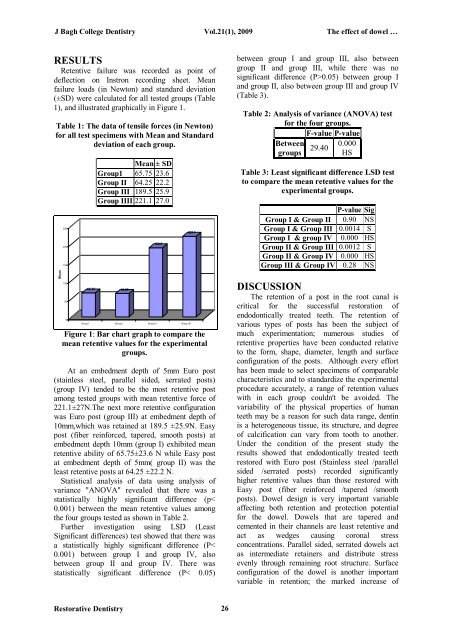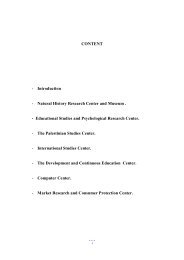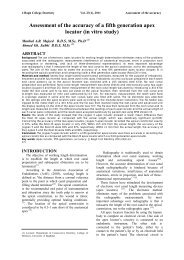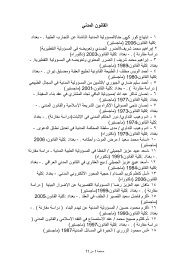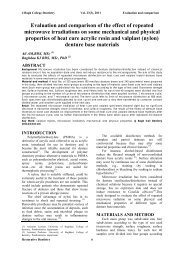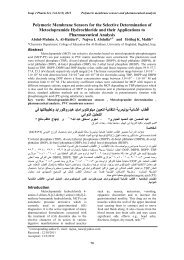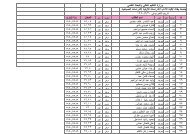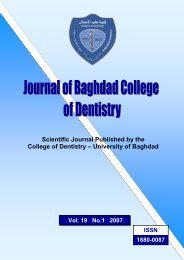Vol 21 No. 1
Vol 21 No. 1
Vol 21 No. 1
Create successful ePaper yourself
Turn your PDF publications into a flip-book with our unique Google optimized e-Paper software.
J Bagh College Dentistry <strong>Vol</strong>.<strong>21</strong>(1), 2009 The effect of dowel …<br />
RESULTS<br />
Retentive failure was recorded as point of<br />
deflection on Instron recording sheet. Mean<br />
failure loads (in Newton) and standard deviation<br />
(±SD) were calculated for all tested groups (Table<br />
1), and illustrated graphically in Figure 1.<br />
Table 1: The data of tensile forces (in Newton)<br />
for all test specimens with Mean and Standard<br />
deviation of each group.<br />
Mean<br />
250<br />
200<br />
150<br />
100<br />
50<br />
0<br />
Mean ± SD<br />
Group1 65.75 23.6<br />
Group II 64.25 22.2<br />
Group III 189.5 25.9<br />
Group IIII 2<strong>21</strong>.1 27.0<br />
65.75 64.25<br />
189.5<br />
Group1 Group II Group III Group IIII<br />
2<strong>21</strong>.1<br />
Figure 1: Bar chart graph to compare the<br />
mean retentive values for the experimental<br />
groups.<br />
At an embedment depth of 5mm Euro post<br />
(stainless steel, parallel sided, serrated posts)<br />
(group ΙV) tended to be the most retentive post<br />
among tested groups with mean retentive force of<br />
2<strong>21</strong>.1±27N.The next more retentive configuration<br />
was Euro post (group ΙΙΙ) at embedment depth of<br />
10mm,which was retained at 189.5 ±25.9N. Easy<br />
post (fiber reinforced, tapered, smooth posts) at<br />
embedment depth 10mm (group Ι) exhibited mean<br />
retentive ability of 65.75±23.6 N while Easy post<br />
at embedment depth of 5mm( group ΙΙ) was the<br />
least retentive posts at 64.25 ±22.2 N.<br />
Statistical analysis of data using analysis of<br />
variance "ANOVA" revealed that there was a<br />
statistically highly significant difference (p<<br />
0.001) between the mean retentive values among<br />
the four groups tested as shown in Table 2.<br />
Further investigation using LSD (Least<br />
Significant differences) test showed that there was<br />
a statistically highly significant difference (P<<br />
0.001) between group Ι and group ΙV, also<br />
between group ΙI and group ΙV. There was<br />
statistically significant difference (P< 0.05)<br />
between group Ι and group ΙΙΙ, also between<br />
group ΙΙ and group III, while there was no<br />
significant difference (P>0.05) between group Ι<br />
and group ΙΙ, also between group ΙΙΙ and group ΙV<br />
(Table 3).<br />
Table 2: Analysis of variance (ANOVA) test<br />
for the four groups.<br />
F-value P-value<br />
Between<br />
groups<br />
29.40<br />
0.000<br />
HS<br />
Table 3: Least significant difference LSD test<br />
to compare the mean retentive values for the<br />
experimental groups.<br />
P-value Sig<br />
Group I & Group II 0.90 NS<br />
Group I & Group III 0.0014 S<br />
Group I & group IV 0.000 HS<br />
Group II & Group III 0.0012 S<br />
Group II & Group IV 0.000 HS<br />
Group III & Group IV 0.28 NS<br />
DISCUSSION<br />
The retention of a post in the root canal is<br />
critical for the successful restoration of<br />
endodontically treated teeth. The retention of<br />
various types of posts has been the subject of<br />
much experimentation; numerous studies of<br />
retentive properties have been conducted relative<br />
to the form, shape, diameter, length and surface<br />
configuration of the posts. Although every effort<br />
has been made to select specimens of comparable<br />
characteristics and to standardize the experimental<br />
procedure accurately, a range of retention values<br />
with in each group couldn't be avoided. The<br />
variability of the physical properties of human<br />
teeth may be a reason for such data range, dentin<br />
is a heterogeneous tissue, its structure, and degree<br />
of calcification can vary from tooth to another.<br />
Under the condition of the present study the<br />
results showed that endodontically treated teeth<br />
restored with Euro post (Stainless steel /parallel<br />
sided /serrated posts) recorded significantly<br />
higher retentive values than those restored with<br />
Easy post (fiber reinforced /tapered /smooth<br />
posts). Dowel design is very important variable<br />
affecting both retention and protection potential<br />
for the dowel. Dowels that are tapered and<br />
cemented in their channels are least retentive and<br />
act as wedges causing coronal stress<br />
concentrations. Parallel sided, serrated dowels act<br />
as intermediate retainers and distribute stress<br />
evenly through remaining root structure. Surface<br />
configuration of the dowel is another important<br />
variable in retention; the marked increase of<br />
Restorative Dentistry<br />
26


